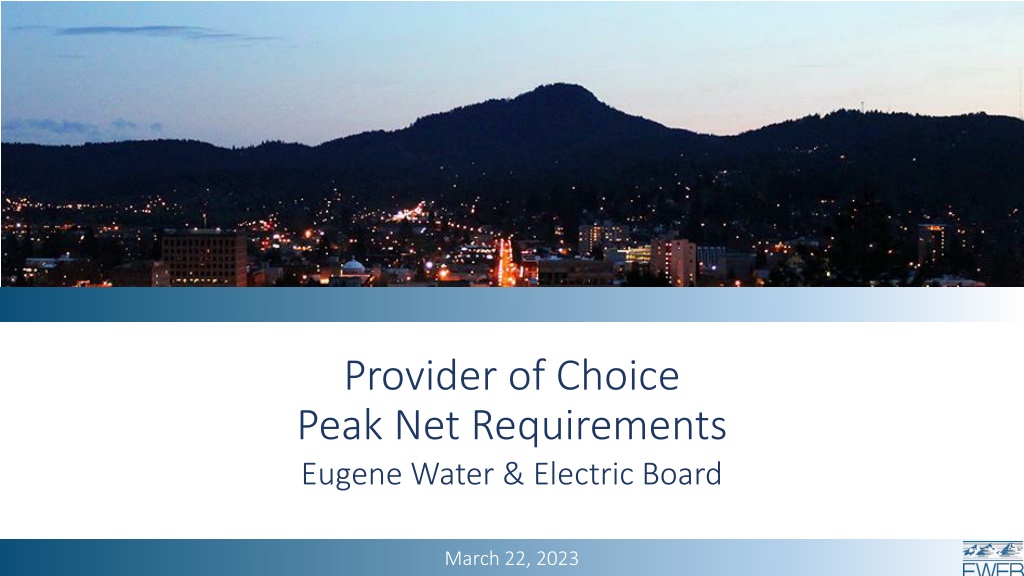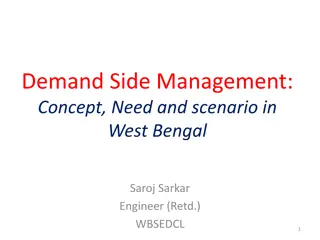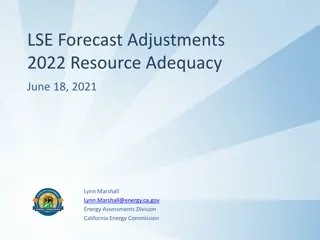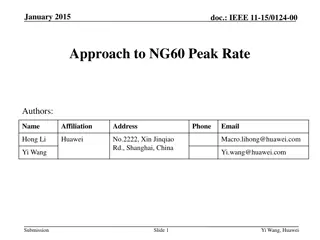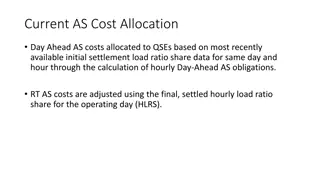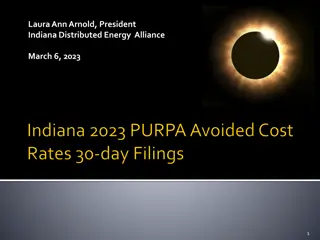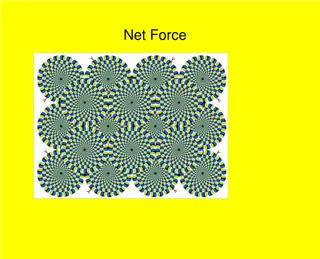Understanding Peak Net Requirements (PNR) in Energy Management
Peak Net Requirements (PNR) is a key concept in energy management, determining the capacity and resource adequacy that utility providers like BPA must offer to meet customer demands. This overview covers the definition of PNR, its relevance to preference customers, and the motivations behind BPA's interest in implementing PNR. Learn about the implications and considerations surrounding PNR in the energy sector.
Download Presentation

Please find below an Image/Link to download the presentation.
The content on the website is provided AS IS for your information and personal use only. It may not be sold, licensed, or shared on other websites without obtaining consent from the author. Download presentation by click this link. If you encounter any issues during the download, it is possible that the publisher has removed the file from their server.
E N D
Presentation Transcript
Provider of Choice Peak Net Requirements Eugene Water & Electric Board March 22, 2023
Key Messages We ve been talking past each other. BPA and planned product customers both want Peak Net Requirements, but have come at it from different perspectives. We need to separate PNR from existing products and discussions of system size and allocation. Existing approaches to using average load worked in the past. Neither BPA nor customers were concerned about capacity, so we did not request a capacity product/definition. We re entering a new paradigm. BPA s current proposal does not meet our needs. We believe all of our interests can be met by including full planning standards (planning reserve margin) in the PNR. Preliminary 7/8/20 results Slide 2 Slide 2
What is Peak Net Requirements (PNR)? Section 5(b) of the Northwest Power Act provides that, whenever requested, Bonneville must offer to sell power to meet the firm power (e.g., retail consumer) load of any public body, cooperative or IOU located within the Pacific Northwest region. The amount of power Bonneville is obligated to supply to the customer under Section 5(b) is equal to the customer s firm power load that is not otherwise served by the customer s own resources. This is referred to as the customer s net requirements. Under Bonneville s organic statutes, Bonneville has broad contract and rate design authority. Bonneville has discretion to develop different ways of supplying power to meet its customers net requirements load. Bonneville also has discretion to establish reasonable terms and conditions for those sales. Preliminary 7/8/20 results *From section 4.1 of BPA s 2022 Provider of Choice Concept Paper. Slide 3 Slide 3
What is PNR? Peak Net Requirements (PNR) is a calculation of BPA s obligation to preference customers. It establishes a minimum and maximum amount of capacity/resource adequacy that BPA can offer as a PF product. PNR is not: A rate construct. A tiering methodology. BPA s net requirement obligations inherently apply differently to real-time load service (load following), and planned products (Slice/Block). One is based on planned loads. One is based on actual loads (consumption). Preliminary 7/8/20 results Slide 4 Slide 4
Why does BPA want PNR? We have heard from BPA: An interest in ensuring that the federal system is being used to serve preference load. Concern that Slice product customers have surplus capacity at times when that capacity is needed to serve load following. (this can happen, and can be addressed) Concern that customers are not using their dedicated resources to meet their peak loads. Concern that providing additional capacity for planned product needs could be remarketed if those needs don t materialize. This is a product concern - we are interested in capacity to meet planning needs, not to remarket. Preliminary 7/8/20 results Slide 5 Slide 5
Is EWEB open to PNR? EWEB s interests Define PNR in a way that is consistent with regional standards as well as load service and planning obligations. We want to be able to buy PF capacity to meet our WRAP requirements and reimburse BPA for that capacity. We are actively exploring all products, and want multiple viable options. We want to work with BPA to define the differences and tradeoffs between a planning standard and an operational product . Preliminary 7/8/20 results Slide 6 Slide 6
Our goals are different (but the same)! We do not believe our interests are mutually exclusive. Meeting BPA s interests: We believe concerns about Slice surplus can be mitigated through the Slice customer proposal. We believe broader concerns about use of federal capacity can be mitigated by sideboards, as well as operational features of the WRAP. These are product features, not PNR features. Meeting EWEB s interests: EWEB does not believe including full planning standards in PNR harms BPA s other goals. Instead, it promotes equity between product options. Defining PNR as BPA proposes would mean that BPA COULD NOT offer a planned PF product to provide capacity for EWEB to meet WRAP obligations. Preliminary 7/8/20 results Slide 7 Slide 7
Were entering a new paradigm We recognize that under the current contract planned product customers manage their own peak planning needs as well as within-year resource/load variations. That is a contract construct, and not related to our actual planning need. The old construct with average energy and critical water worked for allocation and meeting customer energy needs in a hydro-dominant system. This was considered prudent at the time, given regional system dynamics and adequacy needs. Moving forward, we need to consider a new approach. This incorporates prudent planning metrics for PNR. We want BPA to provide equitable products that support customers in meeting regional adequacy and policy goals. We now have consistent metrics to use across all customers. We now have clearer planning obligations and operational parameters. Participation in markets and climate policy goals are keys drivers for change. Preliminary 7/8/20 results Slide 8 Slide 8
The past is not the present From BPA s PNR Issue Statement At the time of the development of the 2008 Regional Dialogue contracts, capacity was not forecasted to be constrained, and although BPA had the contractual right to adopt a PNR through a public process, there was sufficient surplus capacity on a planning basis to not merit doing so. As Bonneville works with the region to establish a policy for its post-2028 contracts, Bonneville intends that the products and features created ensure it can meet its power supply obligations for the life of the contracts. Products and services will need to evolve as our view of the future evolves over the contract period. Bonneville is hopeful that it can offer a suite of competitive products and services that will also meet these future planning needs. Preliminary 7/8/20 results Slide 9 Slide 9
BPAs PNR proposal BPA is proposing to use portions of the WRAP methodology as the basis for PNR. As a methodology, WRAP uses average peak loads, expected resource generation during peak events (QCC), and planning reserve margin (PRM). BPA proposes to use P50 loads, resource QCC values, but not full PRM. As such, they are deviating from the WRAP methodology for measuring customers peak obligations. The only PRM BPA s proposal would include is related to uncertainty in a customer s generation. BPA believes that planned product customers are responsible for meeting within-year variations in load. (we agree) BPA does not believe it is responsible for meeting a planned product customer s planning obligations for load variation. (we disagree) For EWEB, this proposal would establish a gap between our planning obligations and net requirement plus dedicated resources in all months. Preliminary 7/8/20 results Slide 10 Slide 10
Peak is not average Today, customers and BPA use the energy net requirement to determine the amount of energy BPA offers on a planning basis. The energy net requirement uses average forecast load. BPA proposes to use a similar approach for peak loads an average peak (1-in-2). However, planning for reliability and peak needs is inherently distinct from planning for average energy needs. Annual energy is for a total amount delivered during a year (averages are standard planning practice). Peak is inherently about individual load events (averages, without PRM, are not a standard planning practice). The energy net requirement metric is conservative, and meets our planning needs and standards. Using critical water means that we have enough energy to cover variations in average load in almost all years. The proposed peak net requirement is not conservative, and does not meet our planning needs and standards. Using average peak loads and a minor adjustment for resource QCC leaves us short of almost half peak load events. Preliminary 7/8/20 results Slide 11 Slide 11
Energy vs peak needs Preliminary 7/8/20 results Slide 12 Slide 12
Undesirable outcomes EWEB and other utilities are forced away from planned products. EWEB and other utilities do not join WRAP because the risk and uncertainty around meeting planning obligations is too high. BPA recalls capacity from a planned product customer, who then has to procure additional capacity to meet WRAP obligations. Planned product customers cannot dedicate resources to load and meet WRAP planning standards. Preliminary 7/8/20 results Slide 13 Slide 13
BPA customers all have the same obligations Peak net requirements is about setting an obligation to serve load. As load serving entities, all BPA customers have the same obligations to provide reliable service, and by proxy, the same needs for reliable planning standards. We believe including full planning standards (PRM) in the PNR calculation creates consistency across customers and aligns with actual customer needs. We can use products and rate design to demarcate how those needs are met, including balancing surpluses and deficits between customers. Preliminary 7/8/20 results Slide 14 Slide 14
Load Following thoughts BPA has proposed to apply to same PNR metric to load following to provide consistency across products. PNR is not useful for the load following product other than as a rate construct. BPA provides real-time service regardless of net requirement calculation. We do not believe the proposed PNR methodology accurately represents BPA s obligation to load following customers (or any customer). EWEB has concerns about how PRM will be priced for load following if 1-in-2 peak loads are a marker for rate mechanisms. Preliminary 7/8/20 results Slide 15 Slide 15
Final thoughts We recognize BPA has broad authority to interpret its statute. We believe it is reasonable for a net requirement calculation to acknowledge prudent planning standards for all customers. Planning to peak events, not average events. We hear BPA s concerns about aligning federal capacity with preference loads. We think this can be addressed with prudent products and WRAP operational requirements (e.g. Slice proposal). We have an opportunity with the development of the WRAP to apply consistent planning metrics across products and customers (with PRM). We are asking for equitable access across products to resource adequacy on a planning basis. Rate mechanisms and product design can help ensure alignment of cost-causation and demarcation of responsibilities. Preliminary 7/8/20 results
